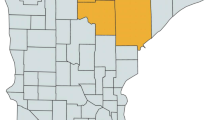Abstract
Landowners manage for multiple objectives (e.g. timber production, wildlife habitat, or as a legacy for heirs) and natural resource professionals (NRPs) are tasked with providing guidance and technical assistance. However, if a landowner is interested in silvopasture, NRPs may be of limited assistance if they are unfamiliar with what the practice entails. To understand their perceptions about and knowledge of silvopasture systems, we surveyed NRPs in four professional categories (Natural Resource Conservation Service, state forestry service, cooperative extension, and registered foresters) within four Southeastern U.S. states (Alabama, Florida, Georgia, and Mississippi). Natural Resource Conservationists were more likely to have been asked about silvopasture practices (59%) than cooperative extension agents (34%) or registered foresters (39%) in these states (p = .001). Georgia and Florida state foresters were asked about silvopasture more often (63% and 67%) than their counterparts in Alabama (29%) or Mississippi (25%). Landowner visits were common (80%) by NRPs, and many provided some form of technical assistance (74%) or print information (58%) to the individuals they served. State forestry service professionals’ differed from other groups most often. Ten of 11 factors presented as potential obstacles to silvopasture establishment and management were ranked by all participants as “somewhat important”. NRPs familiar with silvopasture rated the landowner barriers of “lack [of] technical assistance” (p = .004) and “lack demonstration” (p = .019) as less important than unfamiliar NRPs. Continuing education on silvopasture management could benefit state forestry service professionals and registered foresters in these states.
Similar content being viewed by others
References
Butler BJ (2008) Family forest owners of the United States, 2006. U.S. Department of Agriculture, Forest Service, Northern Research Station, Newtown Square
Dillman DA, Smyth JD, Christian LM, Dillman DA (2009) Internet, mail, and mixed-mode surveys: the tailored design method. Wiley, Hoboken
Ford MM, Zamora DS, Blinn CR, Vaughn S, Burkett E (2019) Landowner and natural resources professional perceptions of silvopasture in central and North-Central Minnesota. J Ext 57(6). https://joe.org/joe/2019december/rb8.php
Frey G, Fike JH (2018) Silvopasture case studies in North Carolina and Virginia. e-Gen. Technical Report SRS-236. Asheville, NC. US Department of Agriculture Forest Service, Southern Research Station
Gold MA, Hanover JW (1987) Agroforestry systems for the temperate zone. Agrofor Syst 5:109–121
Jose S, Dollinger J (2019) Silvopasture: a sustainable livestock production system. Agrofor Syst 93:1–9
Jose S, Kumar BM, Walter D (2017) Ecological considerations in sustainable silvopasture design and management. Agrofor Syst 93:317–331
Kremen C, Merenlender AM (2018) Landscapes that work for biodiversity and people. Science 362(6412):1–8. https://doi.org/10.1126/science.aau6020
Lawrence JH, Hardesty LH (1992) Mapping the territory: agroforestry awareness among Washington State land managers. Agrofor Syst 19:27–36
Lawrence JH, Hardesty LH, Chapman RC, Gill SJ (1992) Agroforestry practices of non-industrial private forest landowners in Washington State. Agrofor Syst 19:37–55
Pattanayak SK, Mercer DE, Sills E, Yang J-C (2003) Taking stock of agroforestry adoption studies. Agrofor Syst 57:173–186
Schoeneberger M, Bentrup G, Patel-Weynand T (2017) Agroforestry: enhancing resiliency in US agricultural landscapes under changing conditions. Gen. Tech. Report WO-96. Washington, DC: U.S. Department of Agriculture, Forest Service. https://doi.org/10.2737/WO-GTR-96
Stutzman E, Barlow RJ, Morse W, Monks D, Teeter L (2019) Targeting educational needs based on natural resource professionals’ familiarity, learning, and perceptions of silvopasture in the southeaster US. Agrofor Syst 93:345–353
Workman SW, Bannister ME, Nair PKR (2003) Agroforestry potential in the southeastern United States: perceptions of landowners and extension professionals. Agrofor Syst 59:73–83
Funding
Funding was provided by Alabama Forests Forever Foundation.
Author information
Authors and Affiliations
Corresponding author
Additional information
Publisher's Note
Springer Nature remains neutral with regard to jurisdictional claims in published maps and institutional affiliations.
Rights and permissions
About this article
Cite this article
Stutzman, E., Barlow, R.J., Morse, W. et al. Natural resource professionals’ engagement with landowners on silvopasture in the Southeastern United States. Agroforest Syst 94, 2137–2146 (2020). https://doi.org/10.1007/s10457-020-00536-z
Received:
Accepted:
Published:
Issue Date:
DOI: https://doi.org/10.1007/s10457-020-00536-z




